Study of the Engineering Design of a Single-Cylinder High-Pressure Steam Engine with a Corliss Valve Gear
Abstract
:1. Introduction
- The development of immersive virtual and augmented reality experiences to enhance user understanding [30].
- The creation of physical models through additive manufacturing techniques for hands-on exploration.
- The development of WebGL models for interactive online presentations and integration into thematic websites [33].
2. Materials and Methods
3. Results and Discussion
3.1. Corliss Valve Gear System
3.2. Influence of Eccentric Straps on Corliss Valve Gear System
3.3. Crosshead System
3.4. Operation of the Flywheel and Influence of the Crankshaft
3.5. Governor System
3.6. Corliss Valve Gear System Modeling Process
4. Conclusions
Supplementary Materials
Author Contributions
Funding
Institutional Review Board Statement
Informed Consent Statement
Data Availability Statement
Acknowledgments
Conflicts of Interest
References
- Inkster, I. (Ed.) History of Technology; Bloomsbury Academic: London, UK, 2004; Volume 25. [Google Scholar]
- Thoendel, E. Simulation model of the thermodynamic cycle of a three-cylinder double-acting steam engine. Chem. Prod. Process Model. 2008, 3, 21. [Google Scholar] [CrossRef]
- Stokes, P.R. Piston steam engine innovation. Proc. Inst. Mech. Eng. Part A-J. Power Energy 1996, 210, 95–98. [Google Scholar] [CrossRef]
- Rojas-Sola, J.I.; Barranco-Molina, J.C. Engineering Drawing Applied to the Study of the Design of a Two-Cylinder Entablature dddSteam Engine with Parallel Motion Crosshead. Symmetry 2024, 16, 578. [Google Scholar] [CrossRef]
- Rojas-Sola, J.I.; Barranco-Molina, J.C. Analysis from the Functional Viewpoint of a Single-Cylinder Horizontal Steam Engine with a Crosshead Trunk Guide through Engineering Graphics. Symmetry 2024, 16, 722. [Google Scholar] [CrossRef]
- Yatsuzuka, S.; Niiyama, Y.; Fukuda, K.; Muramatsu, K.; Shikazono, N. Experimental and numerical evaluation of liquid-piston steam engine. Energy 2015, 87, 1–9. [Google Scholar] [CrossRef]
- Wang, Y.; Zhou, Z.J.; Zhou, J.H.; Liu, J.Z.; Wang, Z.H.; Cen, K.F. Micro Newcomen steam engine using two-phase working fluid. Energy 2011, 36, 917–921. [Google Scholar] [CrossRef]
- Ceccarelli, M.; Cocconcelli, M. Plans for a Course on the History of Mechanisms and Machine Science. In Trends in Educational Activity in the Field of Mechanism and Machine Theory; Springer: Cham, Switzerland, 2022; pp. 135–144. [Google Scholar] [CrossRef]
- Cocconcelli, M.; Ceccarelli, M. Italian teaching with models from mechanism catalogues in 19th century. In Explorations in the History and Heritage of Machines and Mechanisms; Springer: Cham, Switzerland, 2024; pp. 18–30. [Google Scholar] [CrossRef]
- Ceccarelli, M.; Cocconcelli, M. Italian historical developments of teaching and museum valorization of mechanism models. Machines 2022, 10, 628. [Google Scholar] [CrossRef]
- National Inventors Hall of Fame. George Henry Corliss. Improvements in the Steam Engine. Available online: https://www.invent.org/inductees/george-henry-corliss (accessed on 7 January 2025).
- Lucini, M.; Aleixandre, A.M. Máquinas de Vapor. Carburadores, Mezclas y Ejes; Litoprint: Madrid, España, 1972. (In Spanish) [Google Scholar]
- Inglis, W. On the Corliss expansion valve-gear for stationary engines. Proceeding Inst. Mech. Eng. 1992, 19, 177–194. [Google Scholar] [CrossRef]
- Li, J. The Corliss Steam Engine and the United States Economy in the Late Nineteenth-Century. Master’s Thesis, University of Delaware, Delaware, DE, USA, 2007. [Google Scholar]
- Rosenberg, N.; Trajtenberg, M. A General-Purpose Technology at work: The Corliss steam engine in the late-nineteenth-century United States. J. Econ. Hist. 2004, 64, 61–99. [Google Scholar] [CrossRef]
- Abrams, B.A.; Li, J.; Mulligan, J.G. Did Corliss Steam Engines Fuel Urban Growth in the Late Nineteenth Century? Less Sanguine Results. J. Econ. Hist. 2008, 68, 1172–1176. [Google Scholar] [CrossRef]
- Ferguson, E.S. Power and influence—The Corliss steam engine in the centennial era. Ann. N. Y. Acad. Sci. 1984, 424, 225–246. [Google Scholar] [CrossRef]
- Goodheart, A. The machine of the Myth + the Corliss-engine in machinery-hall at the centennial-exposition in Philadelphia 1876. Des. Q. 1992, 155, 24–28. [Google Scholar] [CrossRef]
- Throp, A. A model condensing Corliss engine: Part 1. Model Eng. 1982, 149, 223–224. [Google Scholar]
- Throp, A. A model condensing Corliss engine: Part 2. Model Eng. 1982, 149, 328–331. [Google Scholar]
- De Waal, J. Arnold Throp’s Corliss Condensing Engine. 2018. Available online: https://modelengineeringwebsite.com/Corliss_drawings.html (accessed on 7 January 2025).
- Chang, K.H. Design Theory and Methods Using CAD/CAE; Academic Press: London, UK, 2014. [Google Scholar]
- Jensen, C.H.; Branoff, T.J. Interpreting Engineering Drawings, 8th ed.; Delmar Cengage Learning: Independence, KY, USA, 2015. [Google Scholar]
- Paris, S.; Gattulli, V.; Landa, A.; Vannini, C. Protecting and redeveloping industrial archaeological heritage through design strategies driven by digital modelling. Conserv. Sci. Cult. Herit. 2023, 23, 331–348. [Google Scholar]
- Soler, J.J.C.; Ruiz, A.M.; Collazo, J.R. The “arte” of marble: An archaeological and digital approach to 19th century hydraulic sawmills in the Almanzora valley (Almeria, Spain). Virtual Archaeol. Rev. 2024, 15, 132–152. [Google Scholar] [CrossRef]
- Shults, R.; Levin, E.; Aukazhiyeva, Z.; Pavelka, K.; Kulichenko, N.; Kalabaev, N.; Sagyndyk, M.; Akhmetova, N. A Study of the accuracy of a 3D indoor camera for industrial archaeology applications. Heritage 2023, 6, 6240–6267. [Google Scholar] [CrossRef]
- Curra, E.; D’Amico, A.; Angelosanti, M. HBIM between Antiquity and Industrial Archaeology: Former Segre Papermill and Sanctuary of Hercules in Tivoli. Sustainability 2022, 14, 1329. [Google Scholar] [CrossRef]
- Principles of Seville on Virtual Archaeology. Available online: https://icomos.es/wp-content/uploads/2020/06/Seville-Principles-IN-ES-FR.pdf (accessed on 7 January 2025).
- London Charter. Available online: https://londoncharter.org (accessed on 7 January 2025).
- Choi, J.W.; Park, J.J.; Jun, H.J. An Interactive Virtual Reality Approach to Understanding Cultural Heritage Through Storyliving: A Case Study of Seoul City Wall (Hanyangdoseong) in South Korea. Appl. Sci. 2024, 14, 11348. [Google Scholar] [CrossRef]
- Zhu, G.; He, L.D.; Jia, X.Y.; Tan, Z.F.; Quin, Q.W. Experimental Study on Vibration and Noise Reduction of Gear Transmission System Based on ISFD. Machines 2024, 12, 531. [Google Scholar] [CrossRef]
- Kozanecki, D.; Wirowski, A.; Rabenda, M. Static and Dynamic Analysis of Bidirectionally Sinusoidal Corrugated Steel Shells-Comparative FEA Study. Appl. Sci. 2024, 14, 7936. [Google Scholar] [CrossRef]
- Varlik, A.; Dursun, I. Three-Dimensional Web-Based Client Presentation of Integrated BIM and GIS for Smart Cities. Buildings 2024, 14, 3021. [Google Scholar] [CrossRef]
- Shih, R.H.; Jumper, L. Parametric Modeling with Autodesk Inventor 2024; SDC Publications: Mission, KS, USA, 2023. [Google Scholar]
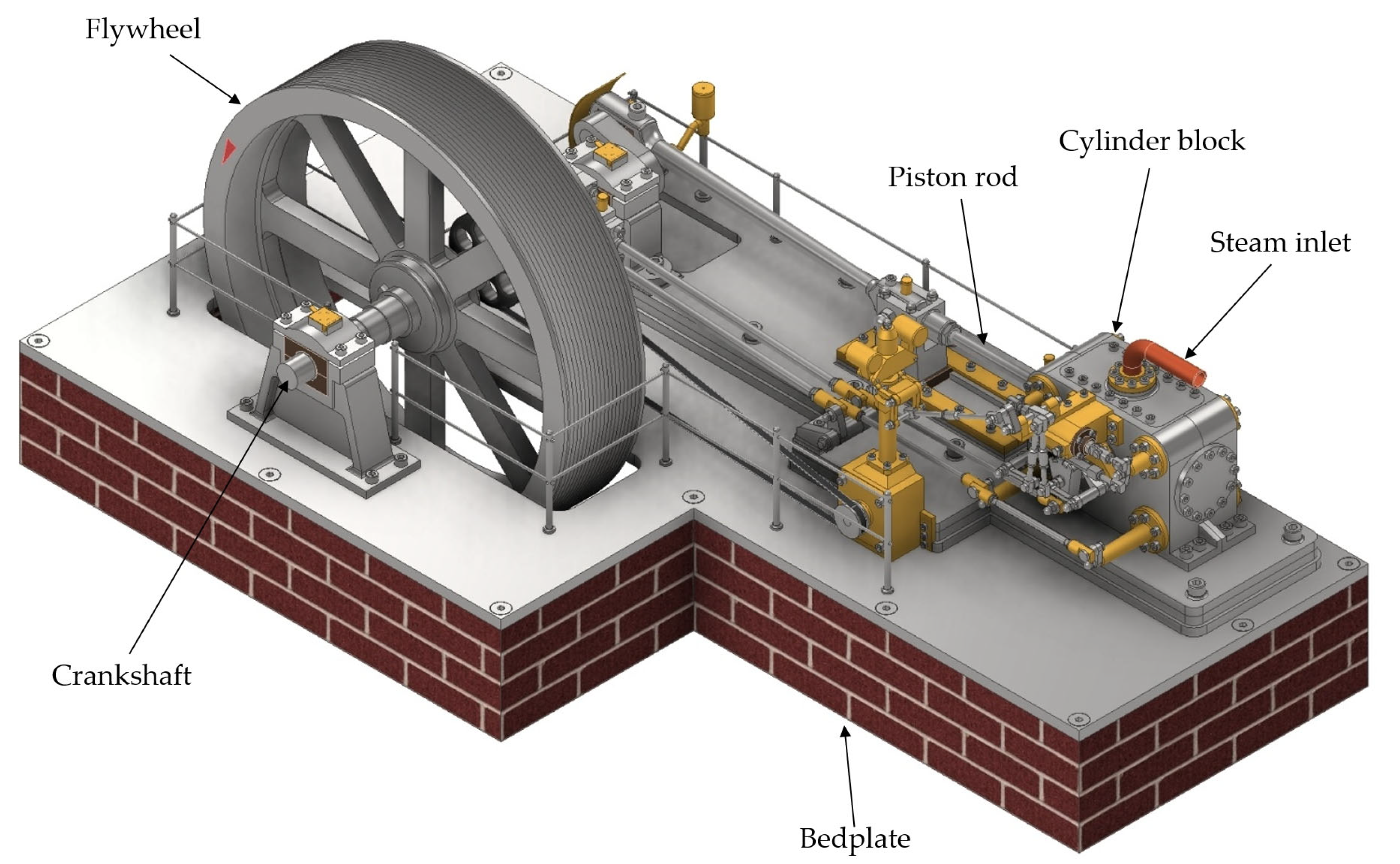

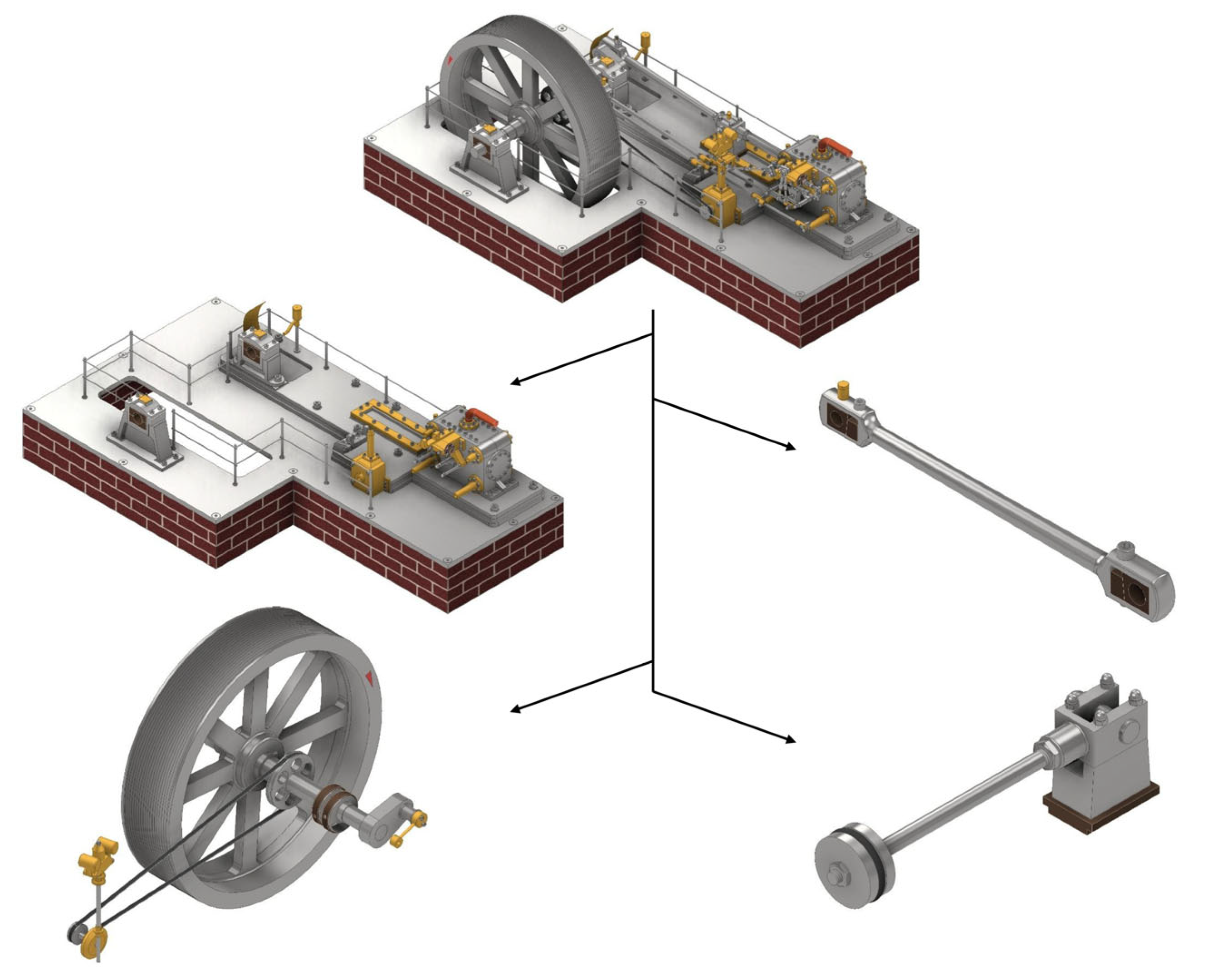
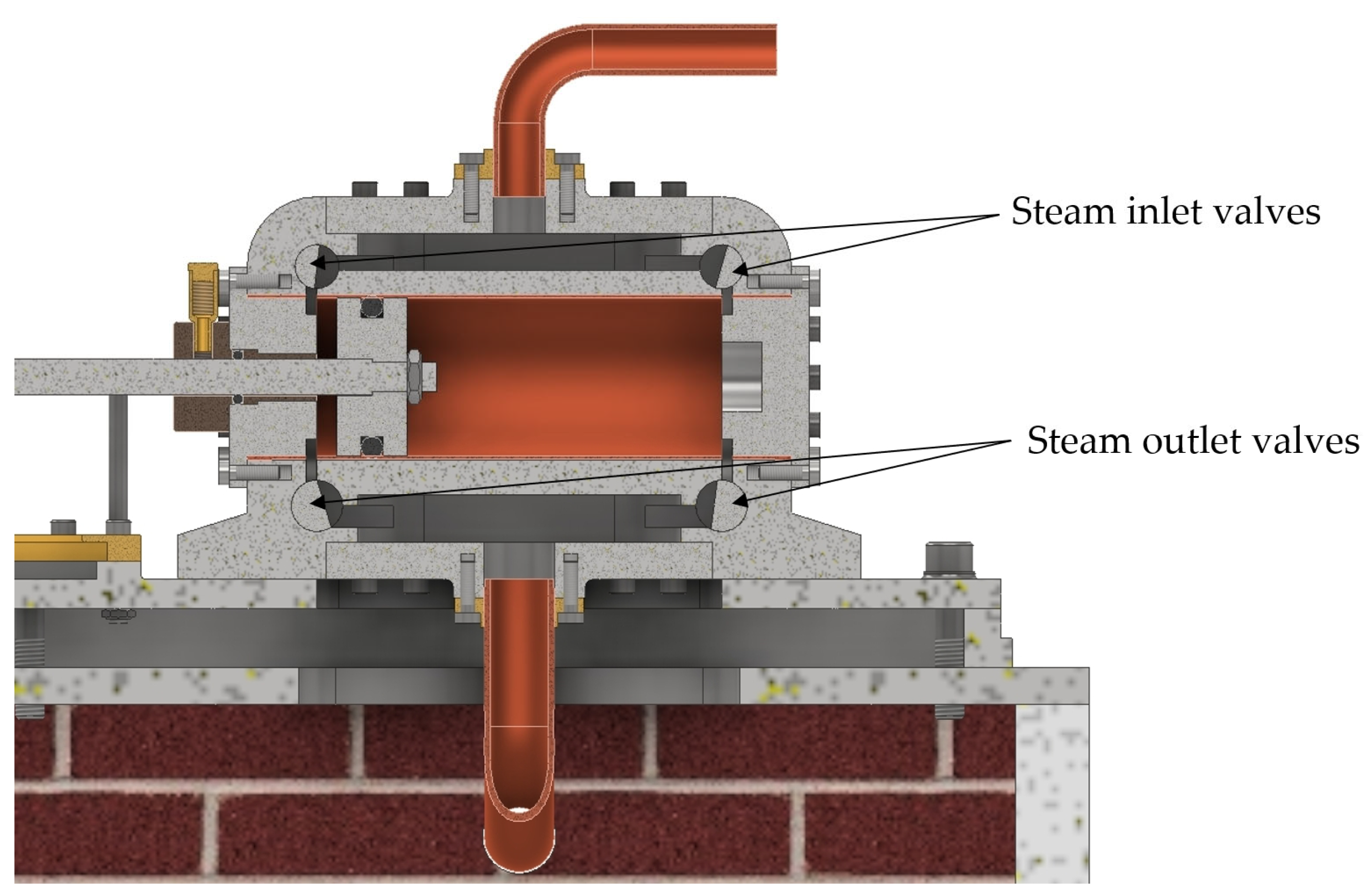
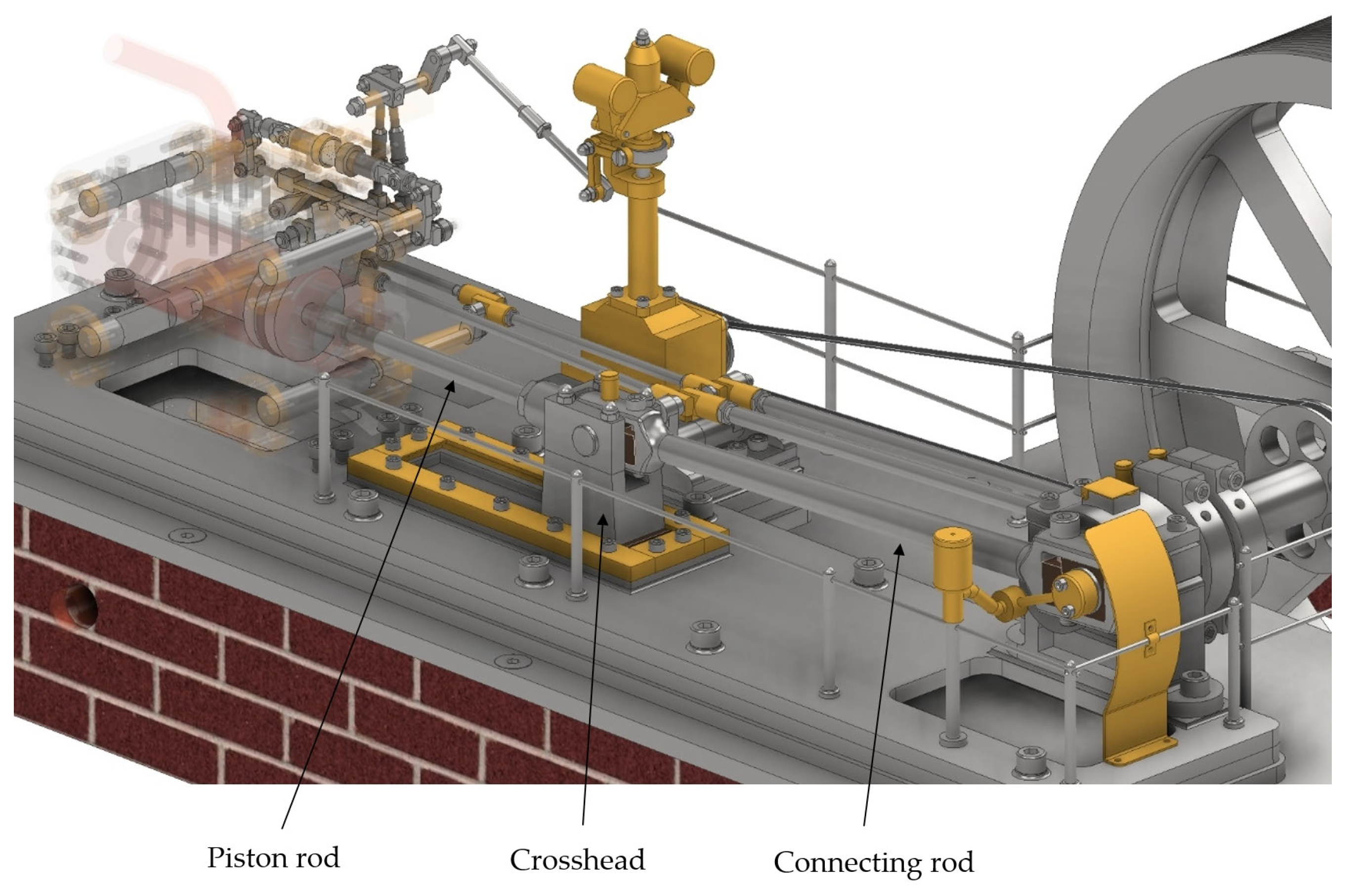

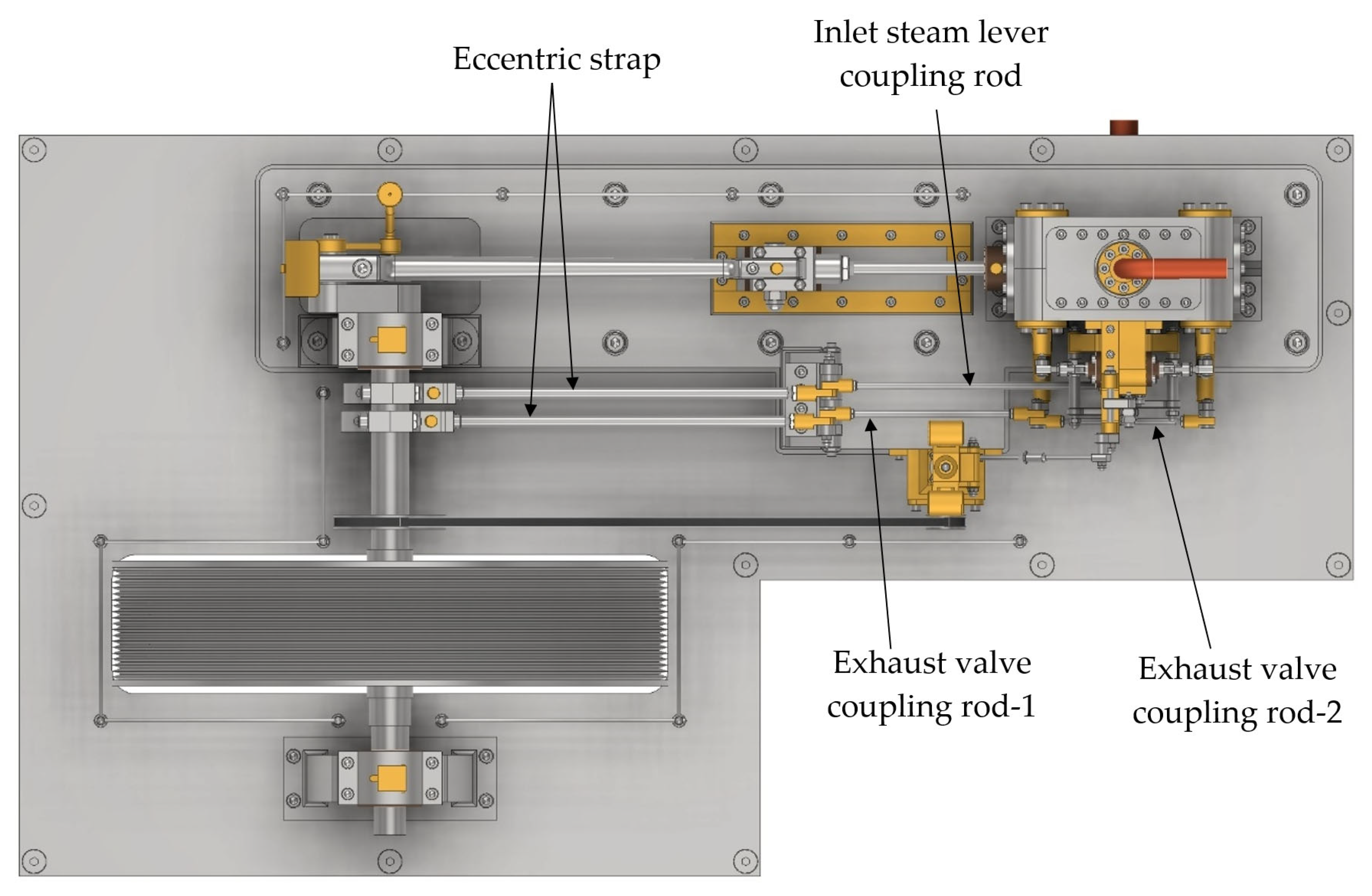





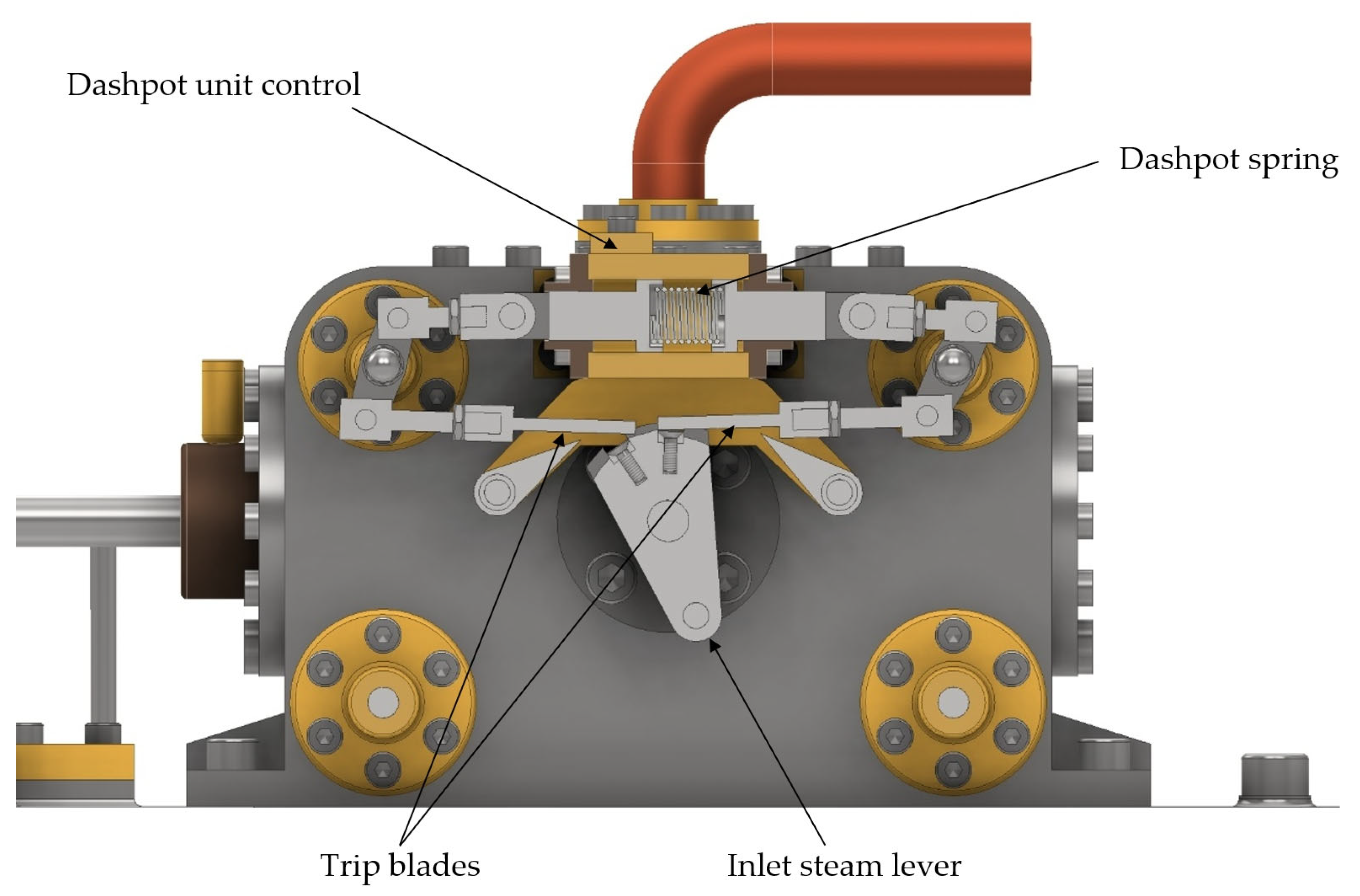

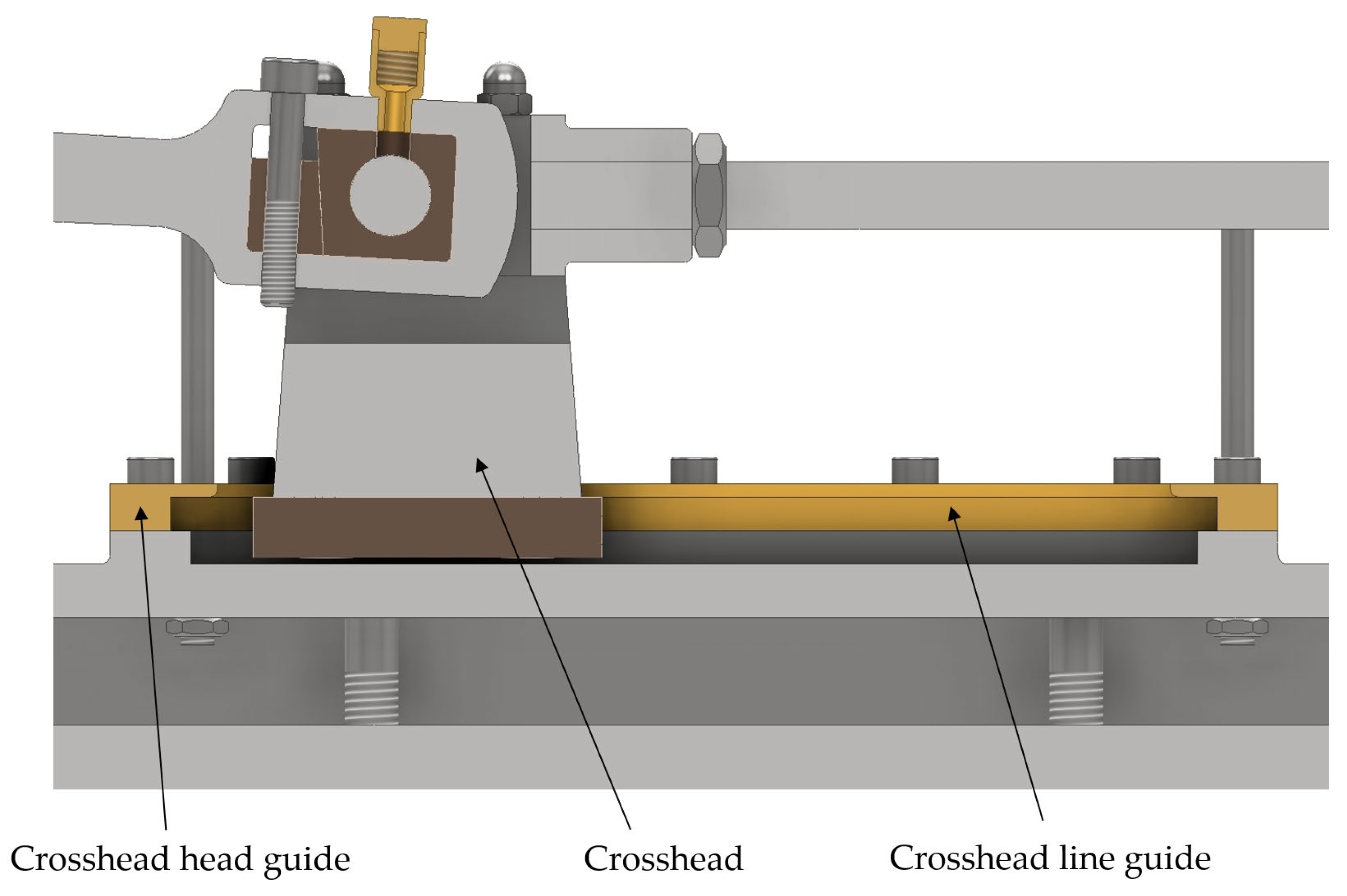
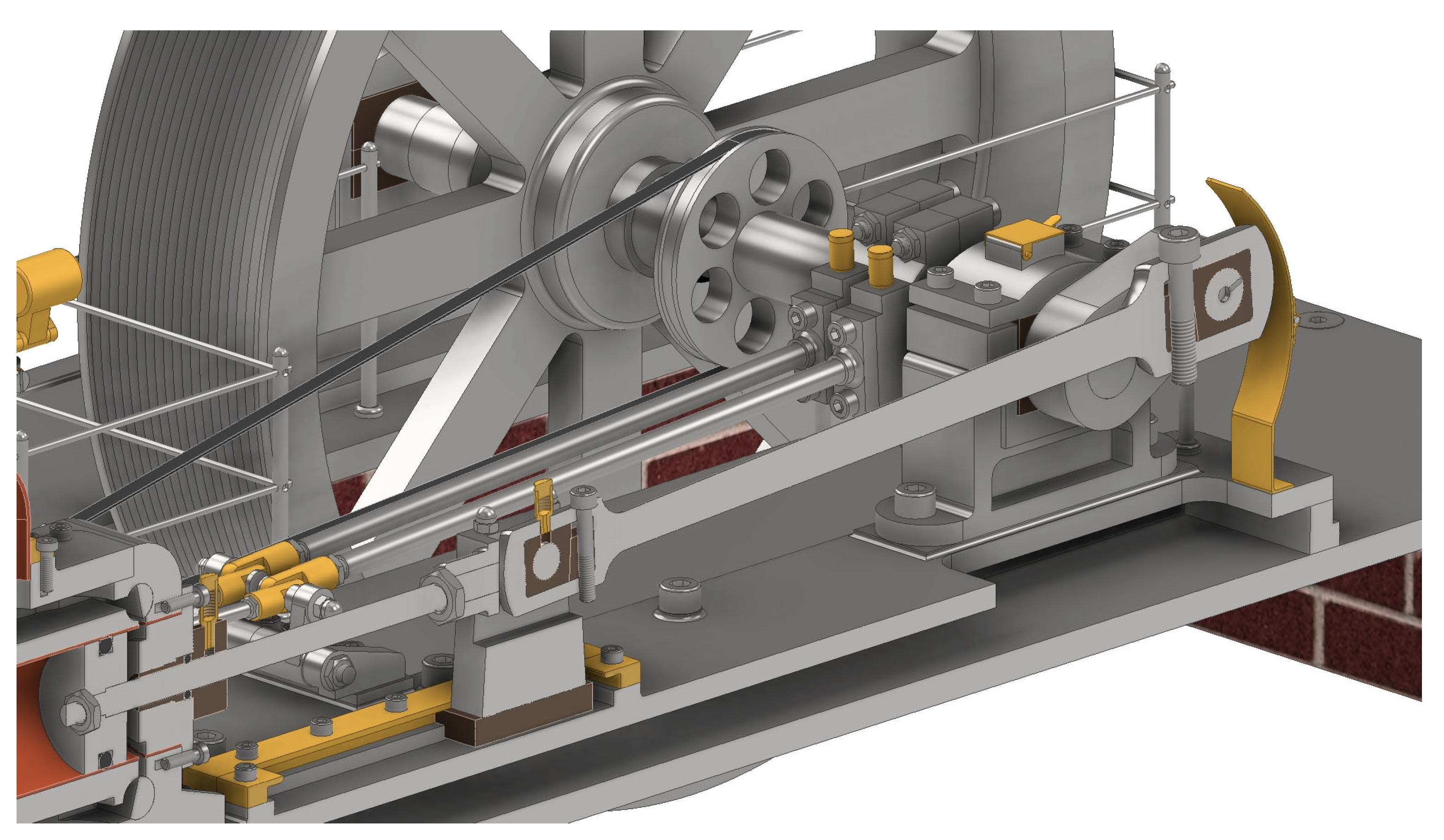
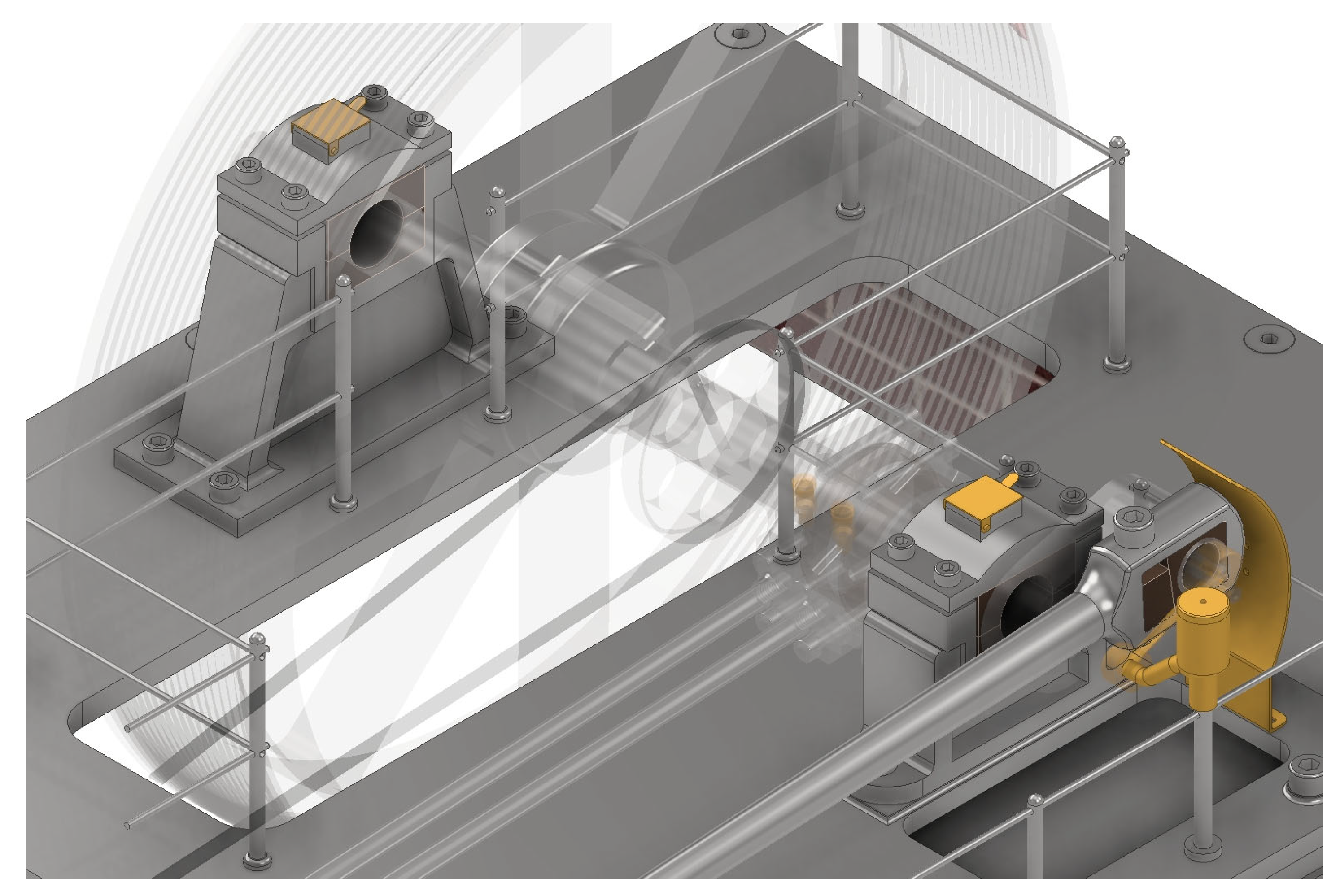
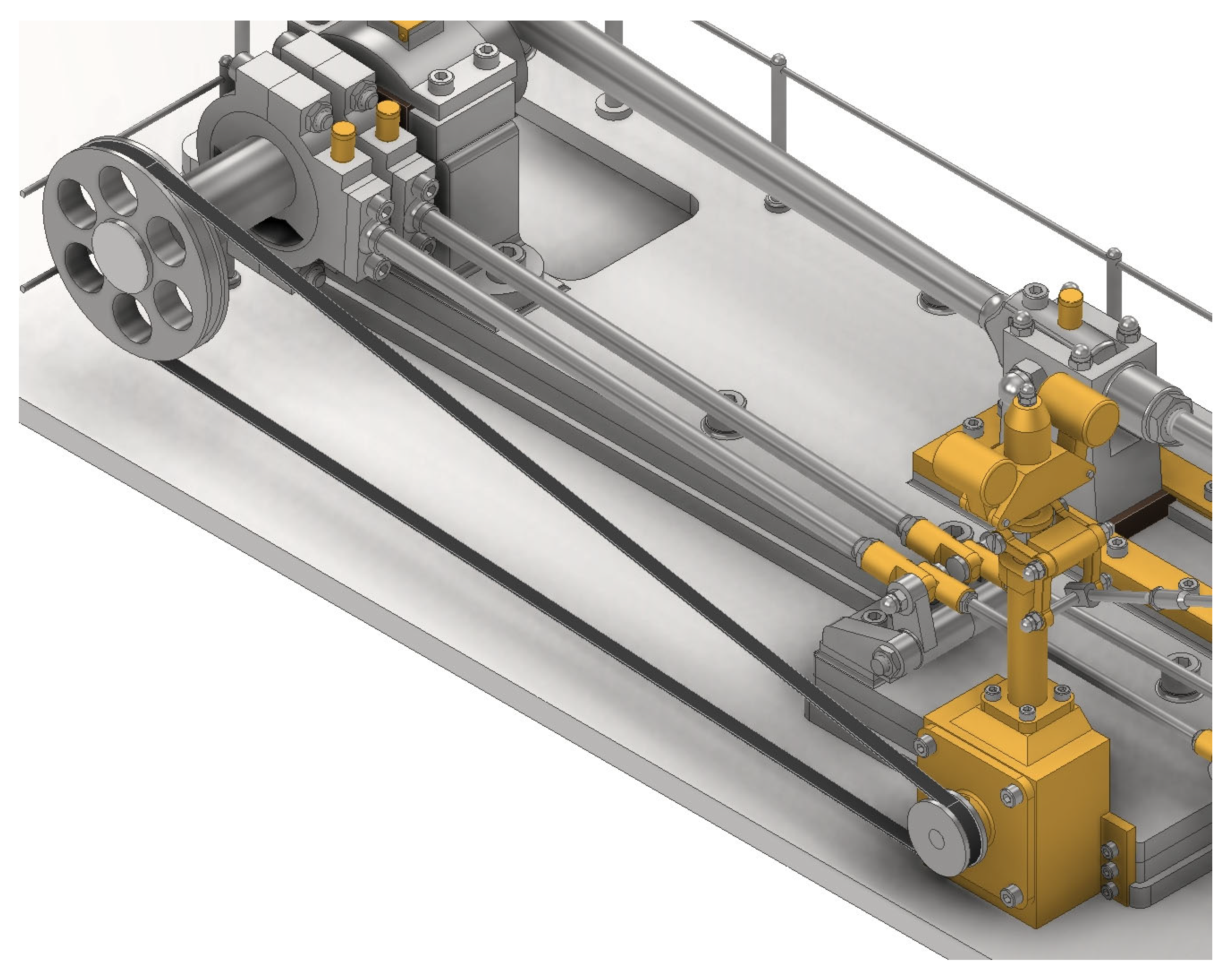
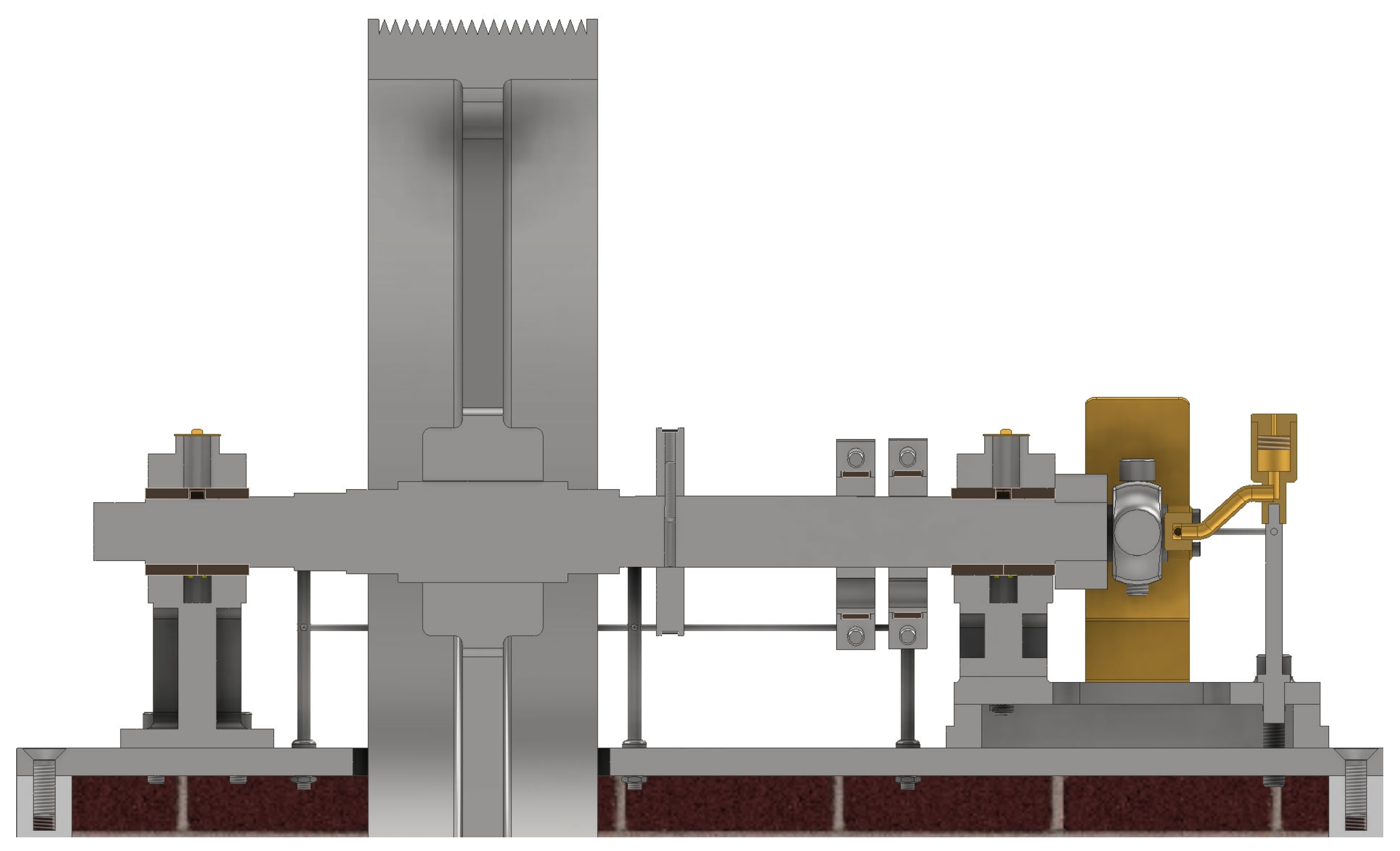
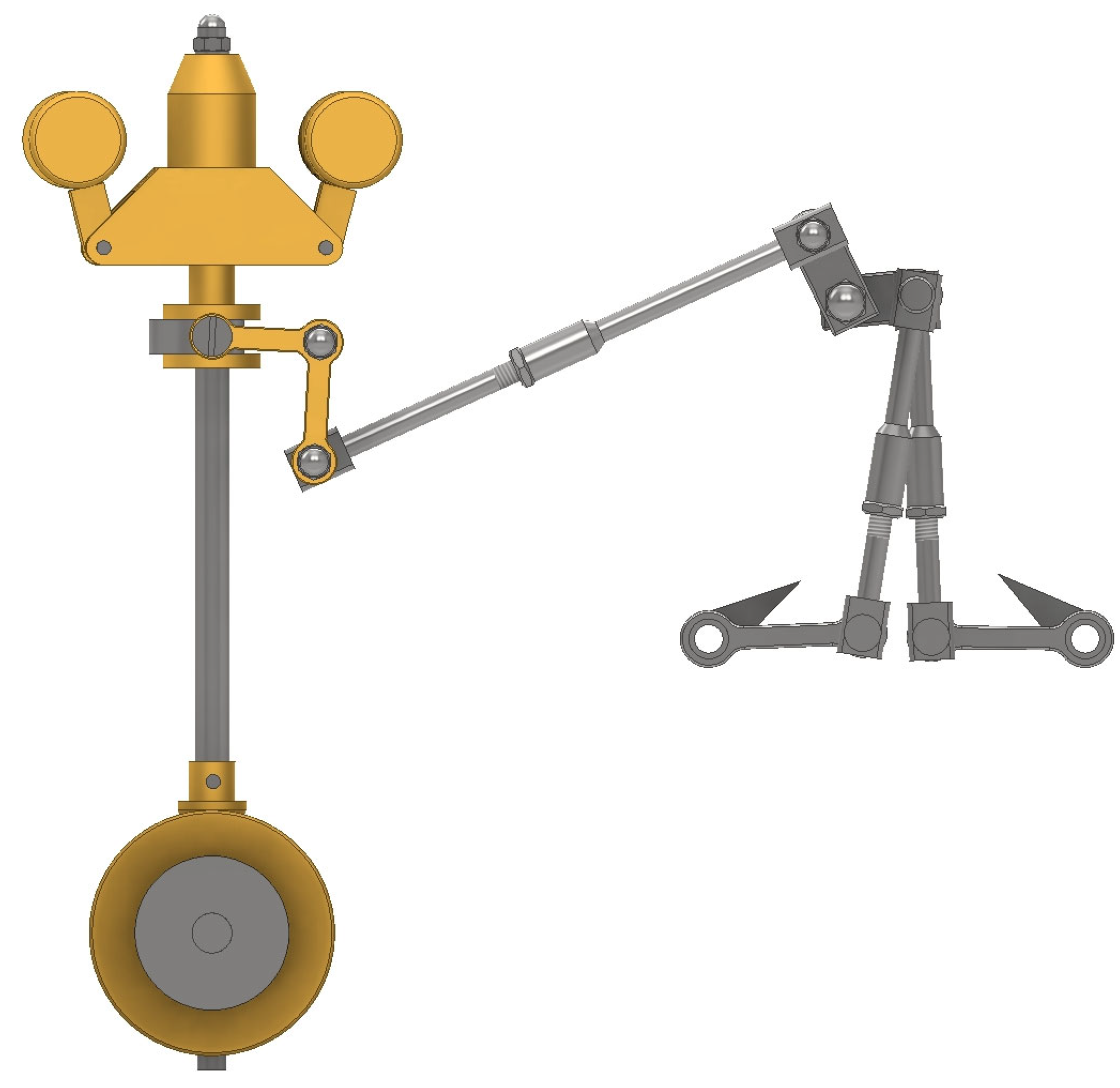
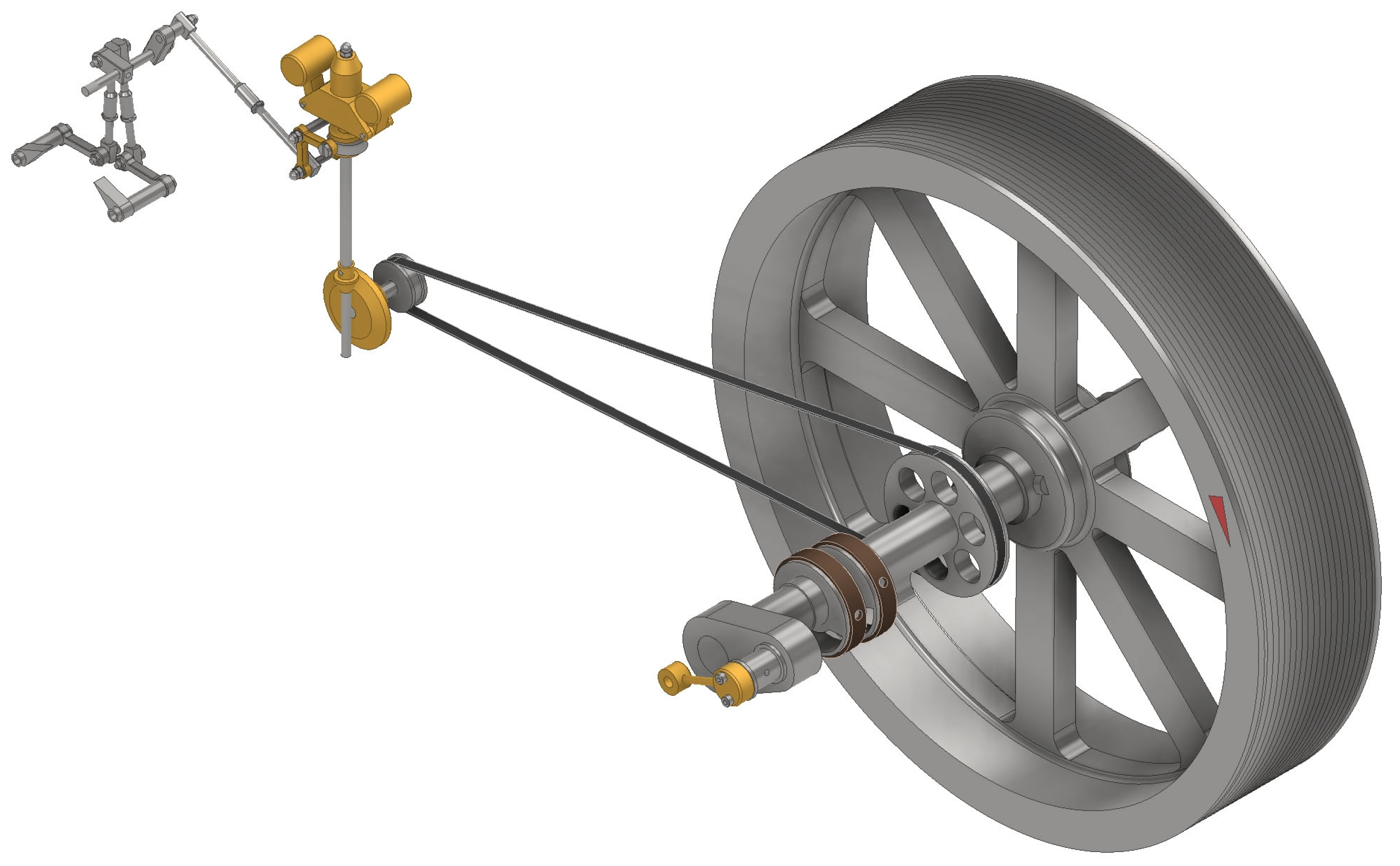

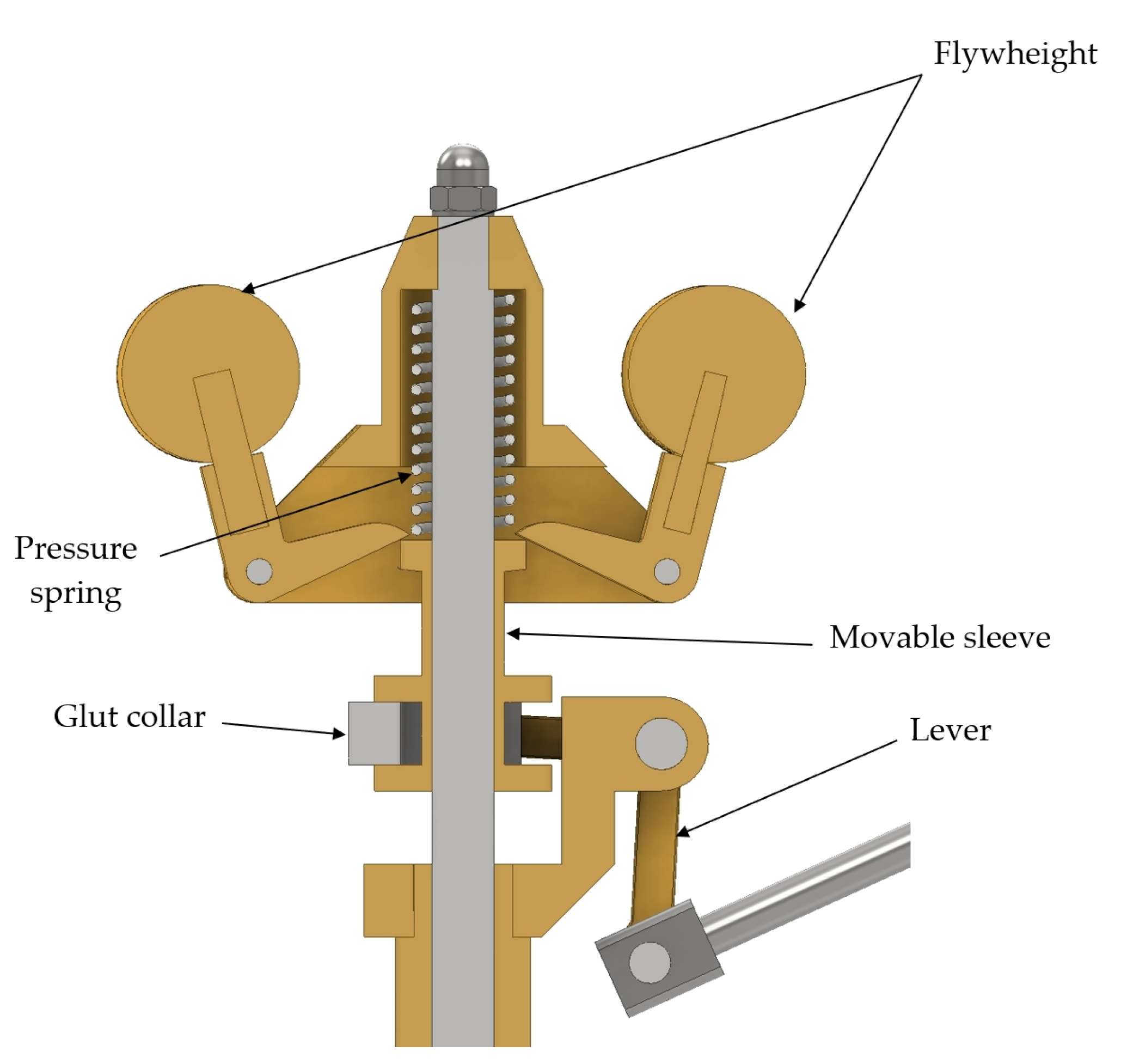
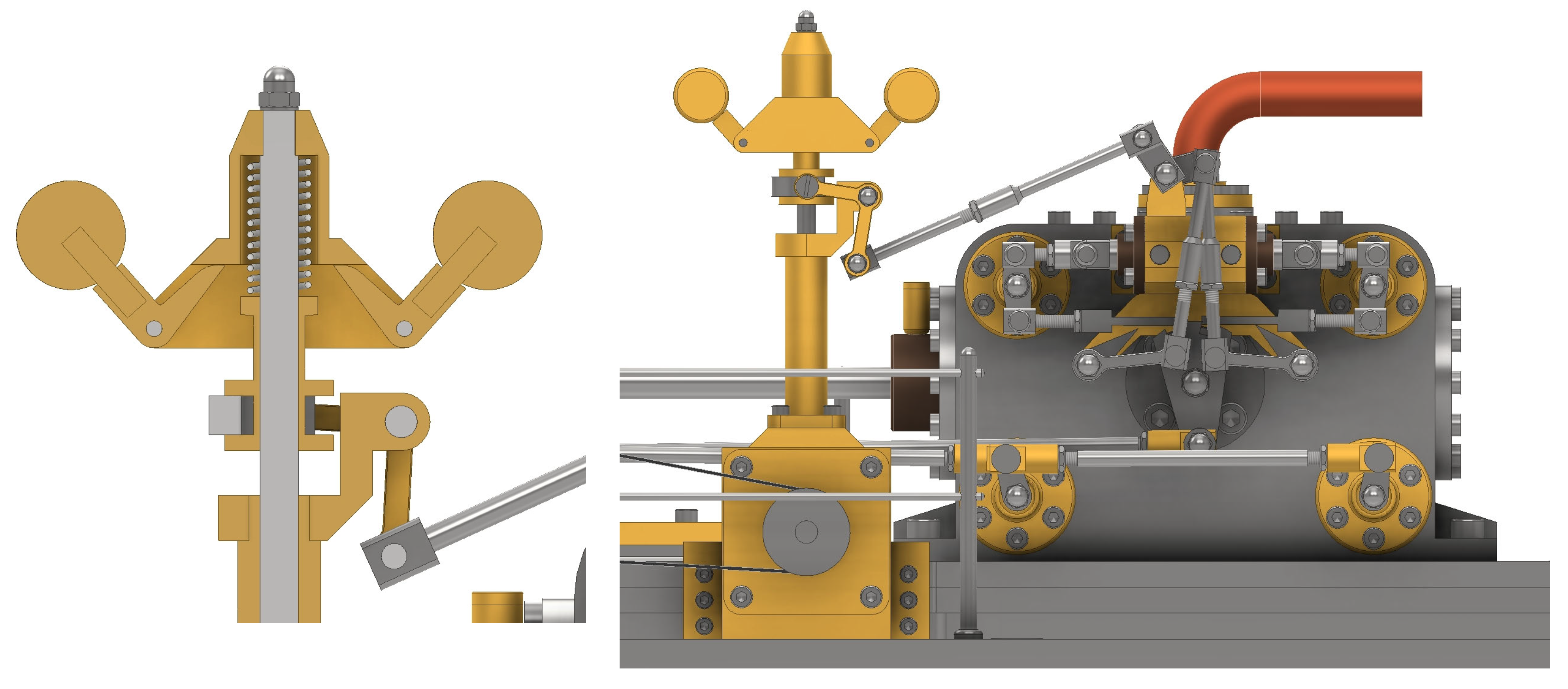

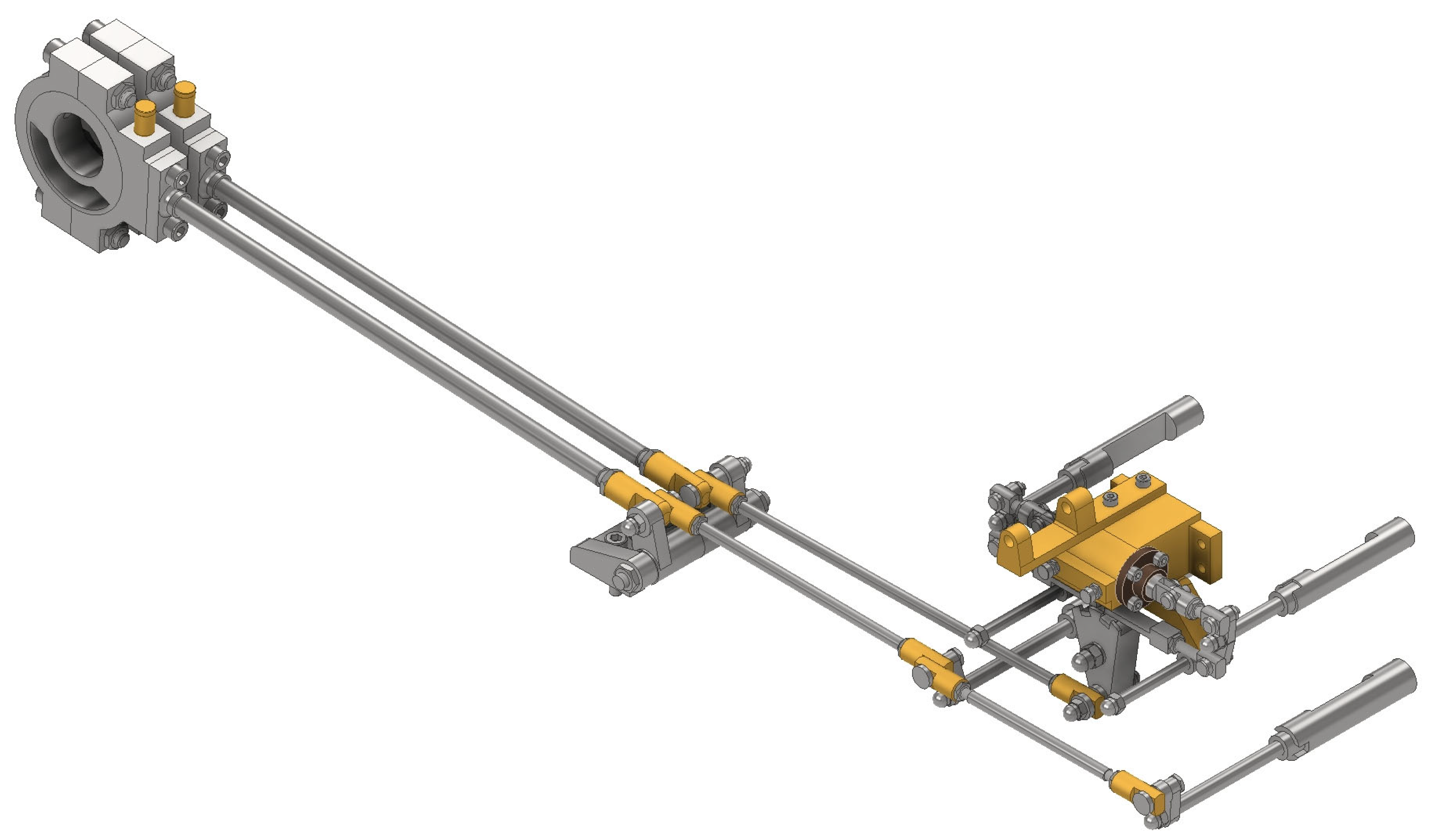





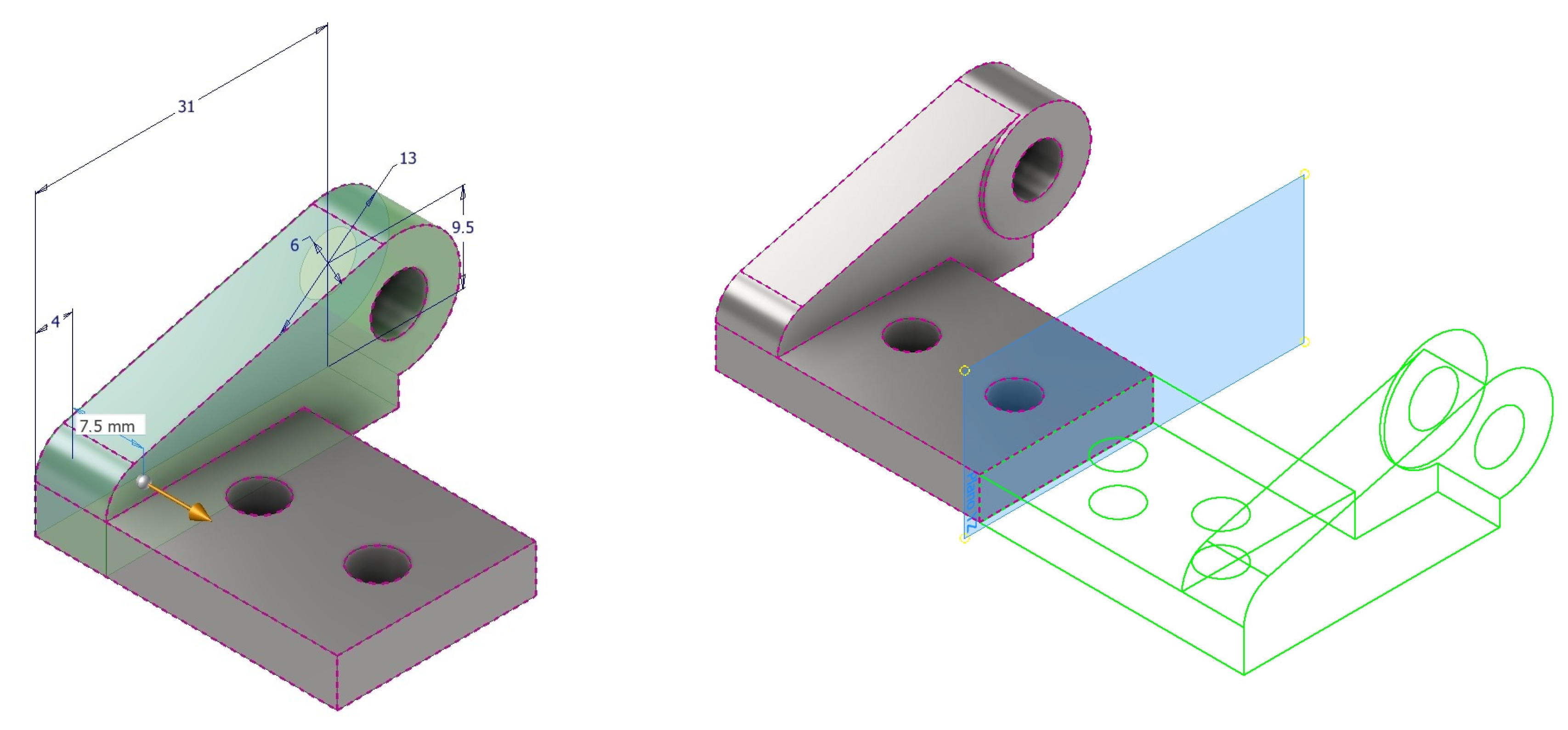






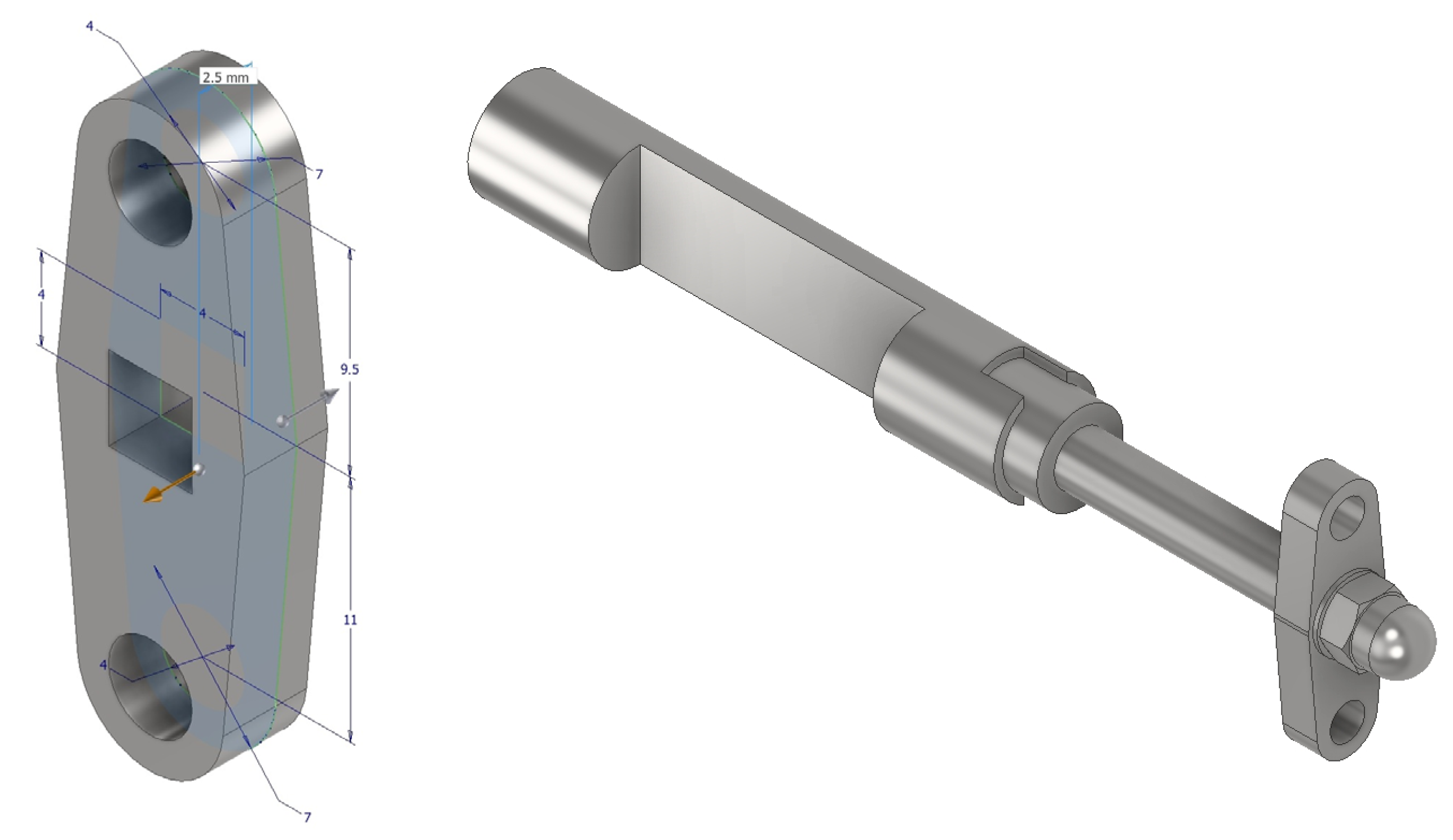



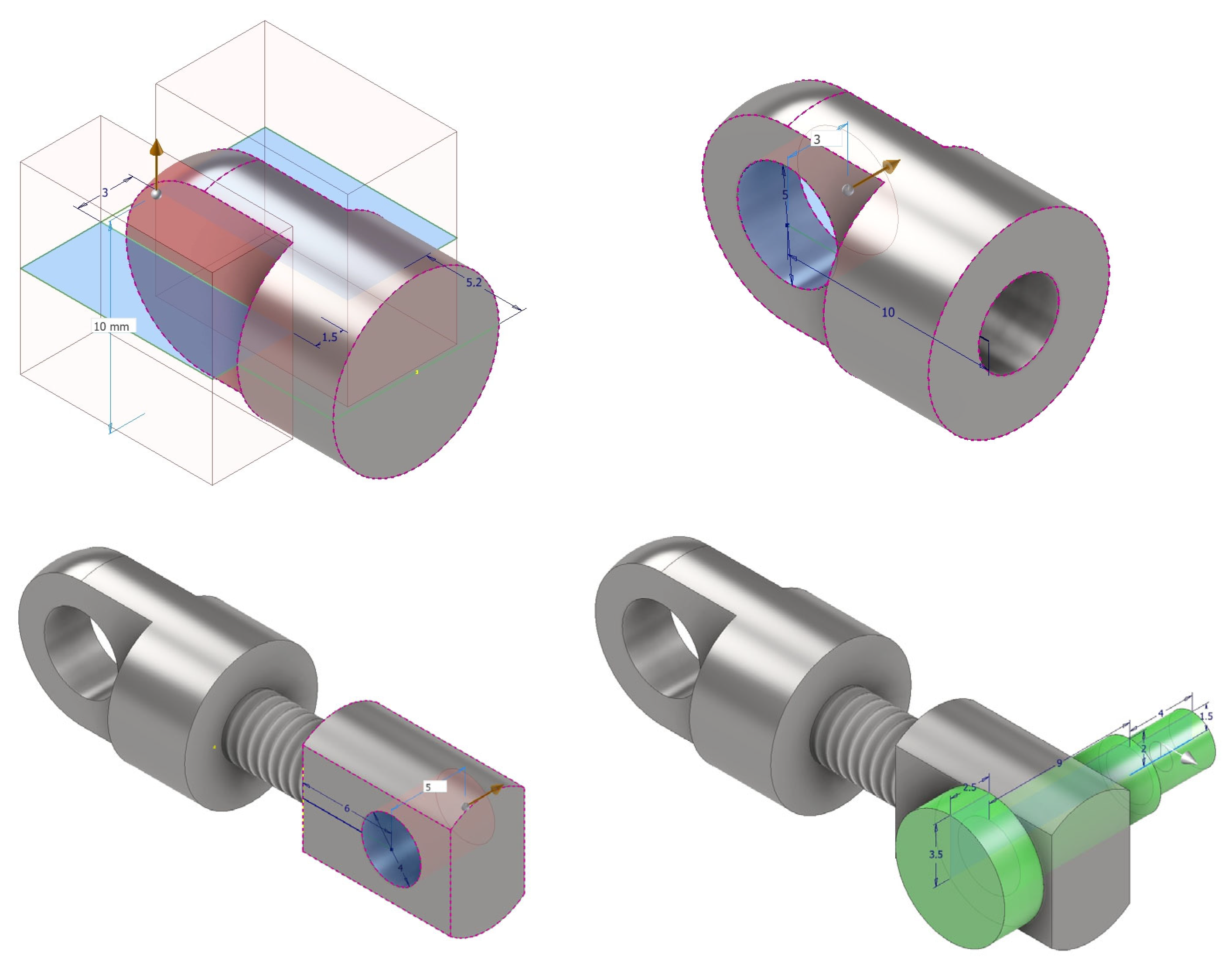



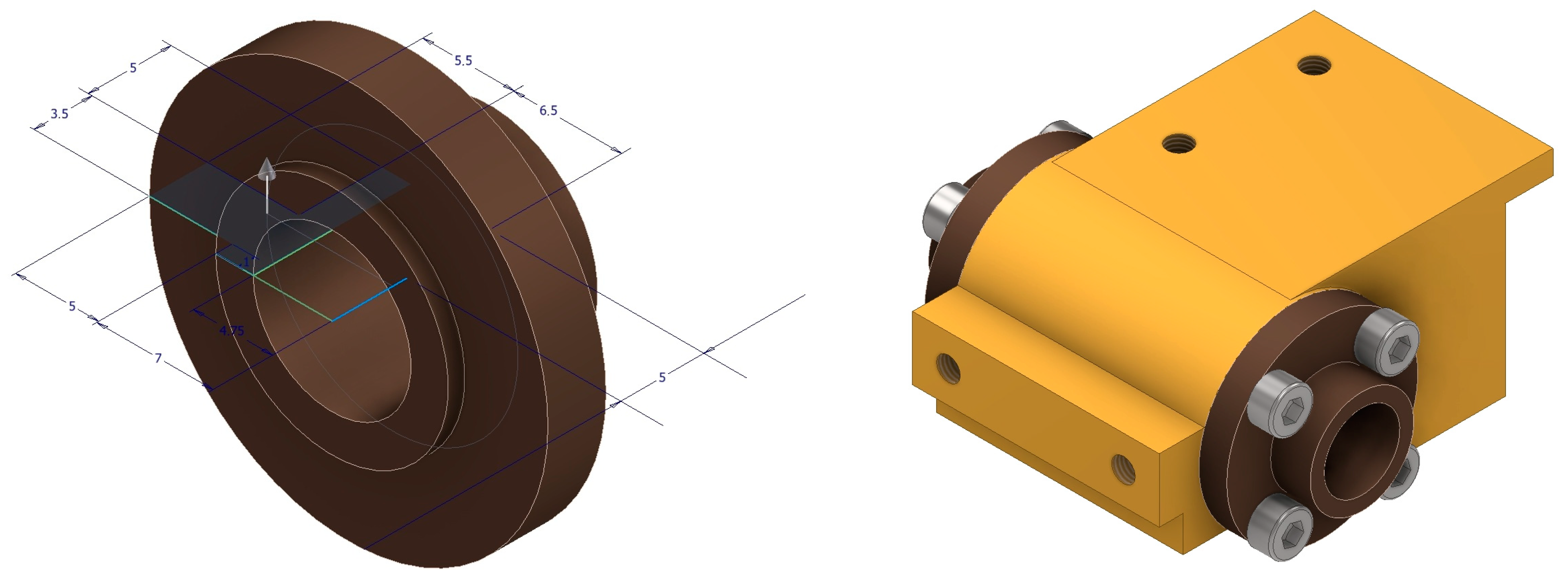

Disclaimer/Publisher’s Note: The statements, opinions and data contained in all publications are solely those of the individual author(s) and contributor(s) and not of MDPI and/or the editor(s). MDPI and/or the editor(s) disclaim responsibility for any injury to people or property resulting from any ideas, methods, instructions or products referred to in the content. |
© 2025 by the authors. Licensee MDPI, Basel, Switzerland. This article is an open access article distributed under the terms and conditions of the Creative Commons Attribution (CC BY) license (https://creativecommons.org/licenses/by/4.0/).
Share and Cite
Rojas-Sola, J.I.; Sánchez-García, S. Study of the Engineering Design of a Single-Cylinder High-Pressure Steam Engine with a Corliss Valve Gear. Appl. Sci. 2025, 15, 3587. https://doi.org/10.3390/app15073587
Rojas-Sola JI, Sánchez-García S. Study of the Engineering Design of a Single-Cylinder High-Pressure Steam Engine with a Corliss Valve Gear. Applied Sciences. 2025; 15(7):3587. https://doi.org/10.3390/app15073587
Chicago/Turabian StyleRojas-Sola, José Ignacio, and Santiago Sánchez-García. 2025. "Study of the Engineering Design of a Single-Cylinder High-Pressure Steam Engine with a Corliss Valve Gear" Applied Sciences 15, no. 7: 3587. https://doi.org/10.3390/app15073587
APA StyleRojas-Sola, J. I., & Sánchez-García, S. (2025). Study of the Engineering Design of a Single-Cylinder High-Pressure Steam Engine with a Corliss Valve Gear. Applied Sciences, 15(7), 3587. https://doi.org/10.3390/app15073587








